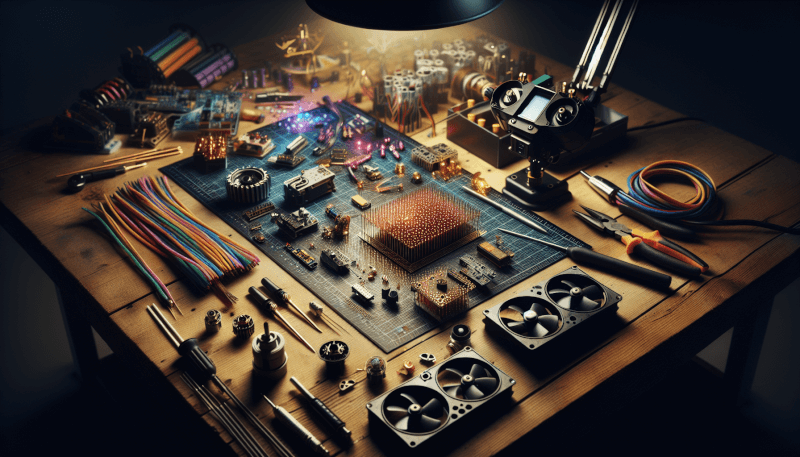So you’ve always been fascinated by remote control helicopters and quadcopters, and now you’re wondering if you can build your very own? The answer is a resounding yes! Building your own RC helicopter or quadcopter can be a fun and rewarding experience that allows you to customize every aspect of your flying machine. From choosing the frame and motors to soldering the electronic components, you’ll have complete control over how your remote control aircrafts looks and functions. Whether you’re a seasoned hobbyist or just starting out, building your own RC helicopter or quadcopter is an exciting adventure that will let your creativity take flight.

Introduction
Have you ever wondered if you can build your own RC helicopter or quadcopter? The answer is a resounding yes! Building your own remote-controlled (RC) aircraft can be a fun and rewarding hobby that allows you to customize your aircraft to your liking, save money, and learn valuable skills along the way. In this comprehensive article, we will explore the benefits of building your own RC helicopter or quadcopter, factors to consider before diving into the project, the components required for building, a step-by-step guide to building your own aircraft, and some tips and best practices to ensure a successful build.
Benefits of Building Your Own RC Helicopter or Quadcopter
1. Customization Options
One of the biggest advantages of building your own RC helicopter or quadcopter is the ability to customize it according to your preferences. By choosing the frame, motors, flight controller, batteries, and other components yourself, you have the freedom to create an aircraft that meets your specific needs and desires. Whether you want a high-speed racing quadcopter or a stable and maneuverable helicopter for aerial photography, the possibilities for customization are endless.
2. Cost Savings
Building your own RC helicopter or quadcopter can also save you a significant amount of money compared to buying a pre-built aircraft. While the initial investment for the components may seem higher, you can often get higher-quality parts at lower prices than what commercial manufacturers offer. Additionally, you have the flexibility to choose components within your budget and upgrade them gradually over time. This cost-saving aspect makes building your own aircraft an attractive option for both beginners and experienced hobbyists.
3. Learning Experience
Building an RC helicopter or quadcopter from scratch provides a valuable learning experience. You will gain a deeper understanding of the mechanics, electronics, and aerodynamics involved in making these aircraft fly. The process of researching, planning, and assembling the various components will enhance your problem-solving skills and expand your knowledge of the hobby. Building your own aircraft also gives you the opportunity to troubleshoot and fix any issues that may arise, further enhancing your knowledge and skills in the field.

Factors to Consider Before Building
Before embarking on the exciting journey of building your own RC helicopter or quadcopter, it’s important to consider a few key factors.
1. Skill Level
Building an RC aircraft requires some level of technical knowledge and skills. If you are a complete beginner, it is recommended to start with a beginner-friendly kit or seek guidance from experienced hobbyists. On the other hand, if you have some experience with electronics and soldering, you may be ready to take on a more complex build. Assess your skill level honestly and choose a project that aligns with your abilities.
2. Time Commitment
Building an RC helicopter or quadcopter is a time-consuming process. It involves researching, sourcing components, assembling, and testing. Consider the amount of time you can dedicate to this project, keeping in mind that it may take several weeks or even months to complete, depending on your availability. It’s important to be patient and allocate sufficient time to ensure a successful build.
3. Budget
Setting a budget is crucial when building your own RC aircraft. Determine how much you are willing to spend on the components and tools required for the build. Remember to factor in any additional costs such as batteries, chargers, and optional accessories. It’s advisable to start with a modest budget for your first build and gradually upgrade components as you gain more experience and knowledge.
Components Required for Building
To build your own RC helicopter or quadcopter, you will need several essential components. Let’s take a closer look at each one:
1. Frame
The frame serves as the foundation of your aircraft, providing structural integrity and support for all other components. There are various types of frames available, such as carbon fiber, aluminum, and plastic, each offering different levels of durability, weight, and flight characteristics. Choose a frame that suits your intended use and budget.
2. Motors
Motors are responsible for spinning the propellers and generating the thrust required for flight. Brushless motors are commonly used in RC helicopters and quadcopters due to their efficiency and power. Consider the motor size, KV rating (rotations per volt), and compatibility with your chosen frame and propellers when selecting the motors for your build.
3. Flight Controller
The flight controller is the brain of your RC aircraft, controlling its stability and flight characteristics. It receives input from various sensors such as gyros, accelerometers, and barometers, allowing it to maintain stability and execute desired maneuvers. Look for a flight controller with features that align with your intended use, whether it’s smooth aerial photography or agile racing.
4. Electronic Speed Controllers (ESCs)
Electronic Speed Controllers (ESCs) regulate the power supplied to the motors, ensuring smooth and precise control. ESCs play a crucial role in providing throttle response, speed control, and motor braking. Choose ESCs that match the specifications of your motors and are compatible with your chosen flight controller.
5. Batteries
Batteries supply the necessary power to your RC aircraft. LiPo (Lithium Polymer) batteries are commonly used due to their high energy density and lighter weight compared to other battery types. Consider the voltage, capacity (mAh), and discharge rate (C rating) of the batteries based on the power requirements of your build and desired flight time.
6. Propellers
Propellers convert the rotational motion of the motors into thrust, propelling your aircraft through the air. They come in various sizes and pitches, each affecting flight performance and efficiency. Consider the recommendations of your motor manufacturer and frame specifications when choosing propellers.
7. Radio Transmitter and Receiver
The radio transmitter and receiver form the communication link between you and your aircraft. The transmitter allows you to send commands, while the receiver receives and relays those commands to the flight controller. Look for a transmitter with a comfortable grip, sufficient range, and customizable features to enhance your flying experience.
8. Other Optional Components
Depending on your needs and preferences, there are several optional components you may choose to include in your build. These may include GPS modules, cameras for aerial photography, FPV (First Person View) systems, LED lights, and more. Consider your intended use and budget when deciding on optional components.

Step-by-Step Guide to Building Your Own RC Helicopter or Quadcopter
Now that you have a thorough understanding of the benefits, factors to consider, and components required for building your own RC helicopter or quadcopter, let’s dive into the step-by-step process of building your aircraft.
1. Research and Planning
Before purchasing any components, conduct thorough research to understand the various options available and determine your specific needs. Consider factors such as flight characteristics, size, and intended use. Create a detailed plan outlining the components you will need and their compatibility with each other.
2. Choosing the Right Frame
Select a frame that aligns with your desired flight characteristics, durability, and budget. Consider factors such as weight, material, and design. Ensure that the frame has adequate space for all the components you plan to install.
3. Installing Motors and Flight Controller
Carefully mount the motors onto the frame according to the manufacturer’s instructions. Attach the flight controller securely, ensuring proper orientation and connection to the sensors.
4. Wiring and Electronic Connections
Take your time to neatly route and connect the various wires between the motors, flight controller, ESCs, and battery. Make sure all connections are secure and properly insulated to avoid any short circuits.
5. Mounting ESCs and Batteries
Attach the ESCs to the frame and connect them to the motors and flight controller according to the manufacturer’s instructions. Securely mount the batteries onto the frame, ensuring proper weight distribution for optimal flight performance.
6. Attaching Propellers
Carefully attach the propellers to the motors, ensuring that they are tightened properly and balanced. Improperly balanced propellers can cause vibrations and affect flight stability.
7. Setting Up Radio Transmitter and Receiver
Follow the instructions provided with your radio transmitter to pair it with the receiver. Configure the transmitter settings according to your preferences and ensure proper communication between the transmitter, receiver, and flight controller.
8. Testing and Calibration
Before taking your RC helicopter or quadcopter for its maiden flight, thoroughly test and calibrate its various components. Check for proper motor rotation, flight controller stabilization, and responsiveness to your commands. Make any necessary adjustments to ensure a safe and stable flight.
Tips and Best Practices
To ensure a successful build and enjoyable flying experience, consider the following tips and best practices:
1. Start with a Kit for Beginners
If you are new to building RC aircraft, starting with a kit specifically designed for beginners can be a great way to learn the basics and gain confidence. These kits typically come with detailed assembly instructions and all the necessary components, simplifying the building process.
2. Follow Assembly Instructions carefully
Whether you are using a kit or sourcing individual components, always carefully read and follow the assembly instructions provided by the manufacturers. Skipping steps or hastily assembling components can lead to costly mistakes or, even worse, unsafe flying conditions.
3. Double-check all Connections
Before each flight, double-check all the connections and wires to ensure they are secure. Loose or improper connections can cause intermittent failures and potentially result in crashes or damage to your aircraft.
4. Take Safety Precautions
When building and flying RC aircraft, it is essential to take appropriate safety precautions. Use protective equipment such as safety goggles and gloves when handling components. Ensure that your flying area is clear and away from people, buildings, and other obstacles. Adhere to local regulations and fly responsibly.
5. Seek Help and Guidance if Needed
If you encounter difficulties or have questions during the building process, don’t hesitate to seek help and guidance from experienced hobbyists or online forums. They can provide valuable insights, troubleshooting tips, and recommendations to help you overcome any challenges.
Conclusion
Building your own RC helicopter or quadcopter can be a fulfilling and exciting journey that allows you to unleash your creativity, save money, and learn valuable skills. By utilizing the benefits of customization, cost savings, and the learning experience, you can create an aircraft tailored to your specific needs and preferences. Remember to consider factors such as skill level, time commitment, and budget before embarking on the build. By carefully selecting and assembling the necessary components, following a step-by-step guide, and implementing best practices, you’ll be well on your way to enjoying the exhilaration of flying your own custom-built RC aircraft. So, what are you waiting for? Start building and let your imagination take flight!


